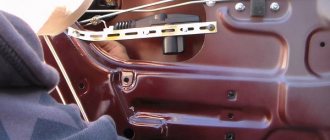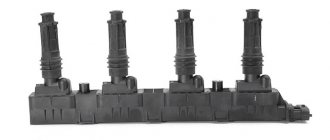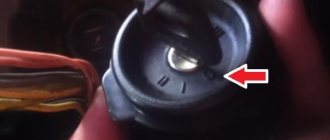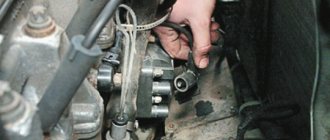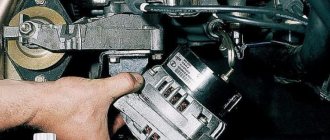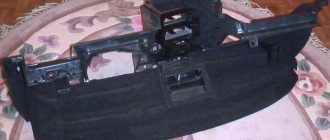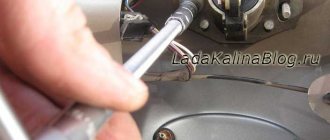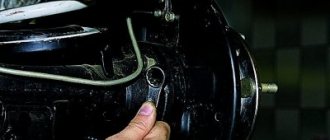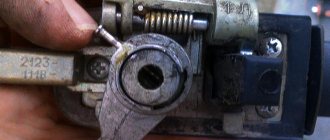You quickly get used to good things and when the central locking breaks down
, then there is no need to delay repairs.
The causes of the breakdown can be determined by the symptoms, and in most cases, repairing the central lock with your own hands
is not difficult.
However, in some cases, the central locking problem
can only be solved by replacing it.
How to install central locking in a VAZ 2110
I won't tell you, because...
Detailed instructions are in the VAZ 2110 documentation (connection diagram for the VAZ 2110 central lock), but I will try to clearly show the various breakdowns of the electric lock
and ways to solve them.
Central locking (CL)
or in another way,
an electric lock
consists of an activator (actuator, electric door lock drive), wiring, traction.
Therefore, if your electric lock is broken and does not work
, then the problem lies in these components.
The VAZ 2110 can use various activators. They may differ in force, small design features, manufacturer/country, etc., but their operating principle is similar:
The principle of operation of the central locking activator In order to understand why the electric lock does not work
, you should consider the principle of its operation:
| Five-wire activator with cover removed. There is a boot above the activator. Two activator wires are connected to the electric motor. The remaining three wires are connected to the limit switch. |
| In this photograph, the fragment with the image of the limit switch is enlarged, it is indicated by the letter “A”. “B”—stem shank in extended position. “C” is the motor shaft with a gear mounted on it. |
| “A” - the rod is extended. “B” - damper rubber rings. They protect the rod and body from damage when impacted in the extreme positions of the rod. |
It is not correct to check the operation of the activator without rigid fixation (without fastening to the door) and without connecting the rod, because after activation to the extreme retracted or extended position, the rod will bounce in the opposite direction.
Power steering VAZ With us you will find any auto parts at competitive prices for your car!avtobazar.ua
Problems with the central locking Let's consider the moment when the driver closes the car, the doors close and immediately open
.
| If we consider this case in detail, it turns out that the rod is retracted almost completely, and the limit switch is in a borderline state (it may or may not be pressed). The limit switch will send a command to the central locking module and the other doors will also close, but as a result of slight deformation of the door or mechanism (for example, a small impact on the car, heating/cooling of the door metal, etc.) the limit switch may switch back and the central lock will open. The defect may appear when closing the door, when the standard mechanism springs the rod and, accordingly, the rod into the reverse position and the doors open again. |
To make sure that this is the problem with the central locking in your case, you need to turn on the alarm while sitting in the car and try to press the door lock button down with your hand (to prevent a spring defect in the mechanism). If the doors do not open, then this means the above-described defect in the mechanism for adjusting and fastening the activator and its rod.
Why is there no such problem with central locking on foreign cars?
Because there the command to open the lock is given by other circuits that do not receive a signal confirming the position of the rod.
If the central locking only works in one direction
, and in the other not, but when an attempt to move occurs, then perhaps the reason is poor fastening of the screw on the activator rod.
The problem is when when closing/opening the central lock there is a rattling sound and the rod does not move
. It's all about the plastic parts. The intermediate gear transmits rotation from the gear on the motor shaft to the teeth of the rod. Because The gear is plastic, then over time the teeth will chip and break. This failure of the central locking system is often found in activators. The pin on which the intermediate gear is mounted breaks the mounting hole, or this hole may be larger than necessary. Hence the skew of the gear, jamming of the activator, and a similar cracking of the teeth from their loose fit. Also, all other plastic elements of the activator can break over time and due to improper installation of the central lock.
Activator motor
has a brass gear, which over time will break down the plastic of the gear, and the gear on the shaft will simply spin.
Problem when the central locking does not work, but the rod can move as usual, by hand
.
Or the central locking does not always work (every other time)
.
In this case, the central locking motor failed. The activator motor is disassembled, where “A” is the commutator pole with a winding soldered to it, “B” is the commutator poles, and “C” is the commutator brushes. The central locking motor may not work for a number of reasons:
- There was a break in the winding
near one of the poles. - If the supply voltage is applied for more than one second, the collector will heat up
and after the end of movement,
the hot collector leads to the melting of the plastic under its plates
.
Because the brushes are spring-loaded, they begin to connect, squeezing out the molten plastic, and when the brushes connect, the central locking power fuse burns out
(after which the activator rod stops moving even manually). Often the reason for this is cheap alarms (for example, there is not enough time for the central locking system to close completely) and the cold season. - Overheating of the motor
due to constant opening/closing in a short period of time (30-40 seconds). - Wear of commutator plates
. In this case, the central locking does not always work, but every other time. The lubricant thickened, or the plastic was squeezed out from under the plates to the top due to the high pulse duration, and the collector overheated. - Inversion of the central lock
. It may be that the standard lock will close when the rod is extended, and open when the rod is retracted. Don’t let this scare you, the main thing is the result of high-quality work of the activator, and the switching of wires can be switched in the cabin near the alarm wires. - The operation of a standard lock can be very difficult
. Perhaps the door trim is interfering, or there is a lack of lubrication in the lock. Difficult operation of the central lock can also be caused by dust and dirt, rust and corrosion. - make the operation of the central lock easier
by removing the spring (used to fix the extreme positions) in the standard lock when the activator force is not enough. - It is advisable to counter the rod fastening screws with paint
(after final fastening, mark a drop of paint on the screw thread and you can tighten it) - When installing and securing the rods, check the operation of the activator, both by hand and by briefly applying voltage from the battery. The movement of the connected rods should be without difficulty. The cause may be deformation of the activator body, bending or deformation of the rod, which will result in failure of the activator.
Car headlights and optics Headlights for cars with delivery throughout Ukraine. Original and analogues. Address and phone number aksmir.com.ua Correct installation of the central locking (activator) Incorrect installation of the activator in the car door increases wear of parts
, which leads to
damage to the central lock
.
Install activator
can be done as desired (vertically, horizontally or at an angle), just as the closure can be by extending the rod or vice versa.
It is important that there is enough space for the activator to work, there is enough space for the rod to pass through, there is also a convenient and reliable connection of the rod, and the fastening is accessible. The operation of the central locking
should be checked with the windows lowered and after installing the door trim.
must be mounted A slight misalignment when fastened to an uneven surface with the force of self-tapping screws can cause difficulty in the operation of the gear shafts. When installing the activator, it is recommended to use washers or bushings to level the surface. If the activator gets into holes in the metal of the door, then it is necessary to use the plate from the activator kit.
The design of the VAZ 2110 door involves bending the rod
, so it is important to bend the rod correctly. The angle should be clear and preferably minimal. If the angle approaches the arc or the distance of the activator attachment from the rod itself is very large, then instead of the effort of moving the standard rod we will get a force to overcome the bend of this arch. It is clearly visible in the second figure, where the activator, pushing the rod upward, will apply force to the standard rod not upward, but to the side.
If the central locking does not work correctly and the activator does not always have enough power
to open or close the door, you should focus your efforts on finding the cause and eliminating the malfunction.
However, enthusiasts found another solution to this problem - they modified the central locking of the VAZ 2110
(installed a second activator).
That is, the second activator is additional and helps the work of the first standard activator. The yellow arrow is the direction of movement of the rod of the standard mechanism, and the red arrow is the movement of the additional activator. In fact, if the activator is installed correctly, an additional activator is not required
and one activator can do its job perfectly.
An example of incorrect installation of the central lock
. The yellow arrow is the movement of the standard rod, the red arrow is the movement of the activator rod. As a result, the force of the rod will be applied to the fracture and the steel rod will eventually begin to pop out of the rod hole. The error can be eliminated by installing plates (green) under the activator (orange). Thus, the activator will be as close as possible to the standard rod and bends in the activator rod will be minimal.
Correct fastening of the lock rod. Element for fastening the rods.
has a through hole for the activator rod and a split side for attachment to the standard rod. If the fixing screws are loosened, then this element should move freely on the activator rod. We select the mounting location and fix the screws with proper force. Push the activator rod down by hand, then push the standard rod in the direction corresponding to the closed state of the door lock.
After both rods are retracted, we fix the screw on the activator rod with medium force. Holding the standard rod in place, we extend the activator rod together with the fastening by 2-3 mm and fix the fastening with medium force on the standard rod of the lock.
Checking work:
We check with our hands the movement of the activator together with the door lock mechanism; the latch must be closed. We check the opening of the latch in the extreme positions of the activator. We check in what positions the remaining doors close. The main thing is that this should not be one of the extreme positions or close to the extreme position of the additional activator. We check the movement of the window lifter. We apply the door trim to ensure subsequent fastening and the absence of protruding elements. If everything is fine, tighten the screws securing the rods with maximum force. We check the operation of the activator by hand again. We check the operation of the activator from the battery. We briefly touch the long wires from the battery to the activator wires, change the polarity and operation of the activator in a different direction.
A number of deviations, amendments and wishes:
If fastening screw No. 2 on the rod becomes loose, then there may be several options
: The rod slides in the hole and the lock does not move. The lock either closes or opens. This happens because the sharp edges of the element (at points 1) can bite the rod and, depending on the upper or lower point, will either only close or, on the contrary, open.
Installing the activator on cable rods Actually, the installation is similar to that described above, but the attachment to the cables of the locking mechanism is shown in the photo. Fig2: Fastening the kit to the metal of the door and fastening the cable in the jacket. Fig3: The cable is released from the jacket between the fastenings. Fig4: Connecting the activator rod to the cable. This kit is difficult to find on sale, so the plate can be cut out of metal yourself, and the spring fastenings can be taken from the Gazelle stove (fastening the cable jacket). Activator.
Conclusion Causes of central locking failure
many, some of them are related to climatic conditions (cold winters, high humidity, etc.), and some are due to incorrect installation or adjustment of the central locking system.
In any case, based on the symptoms, you can understand where approximately or exactly the problem is in the operation of the electric lock
. By the way, do you know how to install additional. central locking button?
This review discusses how to connect an alarm system to the central locking of the following cars: VAZ-21099, as well as 2110 and 2115. There are three standard connection schemes: for central locking controlled by negative polarity, positive and variable. But different cars have their own nuances. Sometimes it is necessary to add a fuse to the “+12 Volt” wire, sometimes, on the contrary, this is not required. VAZ locks, in turn, belong to the simplest type, the first. But the standard scheme published on the Internet is not suitable for them.
Features of the VAZ central lock
Everyone knows that the Lada models listed here use central locking controlled by negative polarity. This literally means the following: we apply “0 Volt” to one wire - all locks close. We apply the same voltage to the other wire (second) - they unlock. This is done in many European cars. What does it mean to “supply “0 Volt”? This means connecting the wire to ground.
Central locking control unit connector
The central locking control unit has the following wiring:
- Black wire – ground (connected all the time);
- Pink – power supply “+12V” (built-in fuse is used);
- Yellow, red - connected to the actuators in the doors (these wires are not connected to the signaling system!);
- Brown, white - control wires, just those that have already been mentioned.
Let's look at the central locking connection diagram, which is implemented “from the factory”:
Standard connection diagram for central locking
First, we may decide that the triangular connector (labeled “C”) is suitable for our purposes, since it contains control contacts. But please note that the standard circuit uses a microswitch located in the driver's door. We will break two wires coming from this switch, and the relays built into the alarm unit will be connected to the breaks. Other options are excluded.
Problem with the operation of the VAZ-2110 central locking control unit
Electronics, of course, are reliable things. Modern control modules for the central locking VAZ 2110 are assembled using a transistor control circuit. This eliminates their mechanical wear. The shelf life of key components is measured in tens of years. The control unit is located under the plastic dashboard cover on the right side of the driver's seat.
However, power transistors can easily fail when the activators are overloaded and the collector is short-circuited. It may even happen that the signal from the control unit will constantly be sent to the lock drive if the transistor is broken. Otherwise, it will simply not turn on.
Checking the control unit is extremely simple. The voltage from the negative terminal of the battery, or directly from the pink wire supplying the control unit, is supplied to the contacts of the gearmotor (activator) in series to the red and yellow conductors. All of the above contacts can be found directly on the eight-pin connector of the control unit.
Thanks for subscribing!
Also, the control unit may issue erroneous control commands due to incorrect operation of the limit sensor. Being a mechanical device, the main door switch can simply wear out. As a result, the control unit simply will not be able to function correctly, since it will not know in what position the car doors are currently located, whether the driver's door lock is closed or open.
Let's make the alarm system and central locking together
Any modern alarm unit is equipped with two relays connected to the central locking control unit. One relay is opening, the second is locking, and the circuit in the general case looks like this:
Control of central locking by supply of “mass”
In our case, the green and white cords coming from the signaling unit will be required, as indicated in the diagram. However, they will not be the only ones needed. We will connect the relay contacts to breaks in the standard wiring. This means there will be not 2, but 4 cords.
Connection diagram for VAZ central locker
Take another look at the diagram published in the first chapter. We will connect the relay to the gap in the white and brown wires going from the microswitch to the central lock control unit. And it is obvious that it is easier to break these wires near the 8-pin connector. The same one shown at the beginning.
To avoid any questions, we will show you what should happen as a result:
Connection diagram, central lock VAZ
The common contacts are connected to the wires coming out of the microphone. The white cord continues with the brown wire coming from the door, and so on. Normally closed contacts are also used, along with normally open ones. These are the features of connecting to the VAZ central locking system.
An approximate sequence of actions performed by the installer:
- Make and lay a 4-core cable running from the signaling unit to the 8-pin connector;
- Connect the cable on the side of the alarm unit (see the last diagram);
- Near the 8-pin connector, disconnect the white and brown wires coming from the microswitch (pins 5 and 7). The main thing is not to confuse them with the wires going to the triangular connector “C”;
- Make connections to the broken wires, white and brown. That's all.
We have given this sequence to emphasize once again that the relays are switched on between the microphone and the central lock control unit. There is no need to connect any additional devices. As a result, the alarm system will be able to control the state of the locks.
Remember that installation is performed by removing the negative terminal from the battery.
All wires added to the car structure must be protected (use heat-resistant tubes or electrical tape). Twisting is not the worst method to connect two wires. But it's even better to use soldering.
It would seem that if a person has experience working with electrical equipment, he can do everything according to the instructions given. As a result, if no mistakes are made, you may encounter an interesting phenomenon. Instead of closing, there will be a short-term locking followed by opening. And vice versa. What to do in this case?
Take a look at what exactly may be present in some of the configurations:
Cheaper - no driver actuator
The driver's door may not have an actuator. And then, it is useless to connect the signaling system to the control unit. There is no actuator, which means there is no one to close or open the door and move the microphone lever. Let's say the locks are closed, and then we remove ground from the brown wire and we get the following: the white wire is on ground, unlocking occurs.
We note the following: installation can only be carried out when you are sure that there is an actuator in the driver's door.
There were configurations where only a microswitch was installed. There is no need for arrogance here - adding an actuator will be difficult, since standard wiring must go to it. As you understand, it may not be available from the factory. And it’s unclear what to do then.
There remains one unanswered question - where exactly the central locking control unit is located. In these VAZ models, if there is a central locking system, then there is also a control unit. And it is located under the torpedo cover, next to the driver, on the right:
VAZ-2110, BU TsZ
We remove the “beard” of the torpedo and look at what is on the upper right. On the same plane with the radio connector there are two boxes attached - the one we need, as well as the immobilizer (if there is one).
We would be lying if we did not say that in reality there is another option for installing the alarm. Standardly, only two power cables go to the actuators. Having a power outlet equipped with a fuse, these cables are connected directly to the alarm relay. This option, as you might guess, is not recommended. Imagine what would happen if the alarm system broke. The central lock must remain, but in this case this will not be done. Happy connection!
Installation of the VAZ-2110 lock actuator
The VAZ-2110 central lock is considered a fairly safe device for the owner of this car. Keeping pace with progress, a person strives to be in time everywhere. This type of transport, such as a car, has long become not a luxury, but a means of transportation. According to statistics, every second person drives a car.
1. Mounting block. 2. 8 A fuse. 3. Control unit. 4. Right front door locking motor. 5. Motor reducer for locking the right rear door. 6. Left rear door locking motor. 7. Motor reducer for locking the left front door with a contact group. A - to power supplies; B - conventional numbering of plugs in the control unit block; C - conventional numbering of plugs in the blocks of geared motors for locking locks.
Today, the products of the domestic automobile industry are not in great demand, since foreign cars dominate the market. But not everyone can afford a foreign car. Therefore, people buy cheaper domestically produced vehicles. One of these cars is the VAZ 2110, which was distinguished by its stable performance, low cost of repair and easy operation.
Adjusting the lock
After 3-4 years of operation, drivers note a defect: one of the doors of the VAZ 2110 car begins to close poorly. For example, it is loose when the part sticks out when closed. It also happens the other way around: when you try to slam the door hard, it doesn’t close. In such cases, adjust the latch. To work you will need good lighting and special tools:
- a large screwdriver with a socket head at the end of the handle;
- a key that will be used as a lever;
- crosshead screwdriver.
Work order:
- Using a screwdriver and a square key placed over it as a lever, partially unscrew all three locking mechanism lock screws. This is necessary to move it relative to the plane on which it is mounted.
- If a closed car door protrudes outward relative to other body elements, then it is necessary to move the latch towards the passenger compartment.
- The adjustment is carried out experimentally. There are no clear parameters for how far the latch needs to be advanced.
During work, it is necessary to check the overall geometry of the body. If the misalignment of the doors occurs due to violation of the geometry parameters, then repair of the locking mechanisms will have to be carried out constantly.
- When the door does not close completely, even if a lot of force is applied to it, it is necessary to move the latch closer to the outer edge of the car body.
- If the gaps between the car door and the body are uneven, this can be corrected by moving the lock up or down. The defect is corrected by adjusting the door hinges, placing washers of various thicknesses.
After the lock is adjusted, the bolts are tightened as tightly as possible.
How the central lock works
Central locking is a system that, when given a certain command, performs the function of opening or closing an object. For ease of use, this operation is performed remotely. Some car enthusiasts choose the function of closing all doors after a certain period of time. It is very convenient for those cases when the driver does not have time or forgets to close the car door.
As a rule, using a long-range remote control you can control both the trunk and the hood, close and open the windows. The most common way to control the remote control is by pressing one button, after which all the locks on the car are activated. If the remote control does not work for some reason, then you need to insert the key into the door lock and turn it clockwise.
If an accident occurs, the car's security system is activated automatically and all locks open. At the heart of the central locking mechanism are incoming sensors located in the structure itself. These are microswitches and door switches (limit switches), actuators and a control unit.
The limit switch must maintain the door position and this information must be transmitted to the control unit. The switches fix the structural part of the door lock. The front doors of the car are equipped with a cam device. To fix the cam, the front doors are equipped with microswitches: there are two parts for each mechanism.
Blocking the lock is formed by one switch, and unlocking is formed by the second. There are two more microswitches used by the central locking mechanism. A fifth switch is installed on the lever device in the lock drive. It serves to determine the door position: when the door is open, the switch contacts close and the central locking system is deactivated.
The electronic mechanism (unit) receives the signal from the microswitches and sends information to the central control. In order to open an object, the central device sends a signal to certain control units, thereby activating the mechanisms in the locks.
What is the central locking on the VAZ 2110?
The purpose of this type of device is to centrally control the automatic mechanism for opening and closing all doors in the car at once. This is especially convenient for working in conjunction with an alarm system and when operating a car in general. However, the reliability of the operation of the central locking system should definitely be checked every time by moving the handles of all four doors before going about your business for a long time, since the actuator can often fail and one of the doors may remain unlocked.
Structurally, the VAZ 2110 central lock consists of the following elements:
- electronic transistor control unit;
- gearmotor actuators, also known as activators (one for each door);
- a limit switch that determines the current state of the door (open or closed);
- electrical wiring and other installation elements.
Central locking diagram for VAZ 2110
Possible problems with the locking system
As we know, any equipment fails sooner or later. And the central locking on the VAZ 2110 is no exception. There are a number of problems that manifest themselves in the operation of this system. Many motorists inadvertently destroy their car's security system. The driver should not give a long or rapid impulse when requesting a door to be opened or closed.
Central locking diagram for VAZ 2110
This action can damage the activator with which the closing device operates. When a long pulse is applied, the collector of the activator electric motor heats up very much. In this regard, the brush holder begins to melt and it may jam. After this, the activator will need to be replaced.
A fuse protects the central locking circuit. It is from this point that they begin to search for faults in the operation of the entire circuit. It is located inside the car, behind the fuse box. According to the diagram, it is located at the break of the pink wire (in insulation). Under the driver's mat there is a wire with a plug connector, which accumulates moisture and oxidizes. The power supply to the activator is lost.
The modular central locking unit may break. You should check its functionality by applying voltage from the battery to the module connector contact. The gear activator gears are made of plastic. Such parts are subject to wear and tear and this is a mechanical failure.
But the solenoid is considered the weakest point of the central lock; most often it is the one that fails. The electromagnet is controlled via a switch. When opening and closing doors, the life of the solenoids is calculated for approximately 10 thousand operations. After this number of switchings, malfunctions begin. The repair is simple: you need to replace the solenoid itself.
Almost connected the alarm, there was a problem connecting the central locking. On the standard block of the VAZ-2110 central lock there are free 6 and 8 contacts. Is this control and what polarity is it controlled by?
can you tell me where it is located?
I installed the signaling system - I was looking for the central locking unit, I looked everywhere, but I couldn’t find it. I got out of the situation by finding wires in the harness from the central locking control. Control - with negative polarity (at least for me)
2002-04-29 11:05
Re: Can you tell me where it is?
The central locking unit is located next to the engine control unit, a little higher, closer to the radio. There is also a standard immobilizer nearby.
2002-04-29 12:43
Re: Control of central locking VAZ-2110?
In my opinion, you need to connect the alarm to the brown and white wires. I don’t remember which one is responsible for opening and which one is responsible for closing. Central locking refers to a three-wire system with negative polarity.
2002-04-29 12:40
Listen here
The central locking unit is located under the center console. It’s better to get to it by unscrewing the left (driver’s) panel at the driver’s feet. But it’s still not visible (I couldn’t). And only by touch, seeing a suitable wiring harness - I reached out to the block with my hand and with great difficulty disconnected the connector from it (Soviet connectors are the most difficult to disconnect - I pulled and pumped for about ten minutes). I confidently advise you to entrust the control of the locks not to this block, but to the signaling itself. The fact is that there have been cases when this unit malfunctions and does not turn off the mechanisms in the doors - the result is that all 4 locks burn together. (When I recently went through TO1, I myself witnessed how a guy on the 10th had all 4 locks and this block changed. According to the guy, they started doing it at 11 o’clock, I left the MOT at 18 o’clock, and the guy had no end in sight to his work — the electricians could not share the blame with the alarm workers). So unplug this connector and connect the signal wires to it. And everything will be OK. Best regards, Evgeniy
Despite the fact that central locking (CL) is installed on almost all cars today, some cars are not equipped with this protection system. Although it is difficult to call it a system, since the only obstacle that the central locking provides for an attacker is the closed doors of the car. Read more about how to install a VAZ 2110 in this article.
Door lock repair
In mechanical structures, repairs come down to replacing or restoring a faulty cylinder, cleaning and lubricating the internal lock mechanism, adjusting or replacing rods. It is not recommended to repair the internal locking mechanism itself, since it is assembled with rivets.
Even if the craftsman removes the rivets and is able to restore the operation of the levers, it will be difficult to put the body back together. If its parts fail, it is better to purchase and install a completely new locking block assembly.
If the door lock does not work correctly, when the key does not turn or the door does not close, you need to do the following:
- Remove the car door trim.
- Remove the door lock cylinder.
- Carefully disassemble the cylinder, thoroughly clean, rinse, lubricate, carefully reassemble in the reverse order and install in its place.
- Remove the internal locking element. Rinse and lubricate. If there is a malfunction, replace it with a new one.
- Check the serviceability of the closing handle mechanism, the door button, all parts are connected to the internal locking mechanism.
- Adjust the locking latch.
If an electronic central unit is installed on a VAZ 2110, then the part is repaired at a service station. Almost none of the car owners have the necessary tools and equipment to check the signal quality and repair the ECU.
How the central lock works
On the VAZ 2110, the central lock is a system designed to open and close vehicle doors. For more convenient control of the central locking on the VAZ 2110, and on other cars, a remote control has long been used. If necessary, the central lock can be configured so that it turns on automatically after a certain period of time. Depending on the system, the key fob can be used to control the trunk door, the engine compartment, and sometimes the central locking system even allows you to open and close the windows. In the event of an accident, the central locking system can operate automatically, opening all doors of the vehicle.
The VAZ central locking system includes sensors in its design - these are door limit switches, solenoids, and a control unit. The limit switch is designed to fix the position of the doors, and data about this, in turn, is transmitted to the VAZ 2110. The purpose of the switches is to secure the structural elements of the door lock.
The system itself is locked using one switch, and the unlocking function is performed by another sensor. The design includes two more switches that ensure normal operation of the locking mechanism. Another one, the fifth switch, is mounted on the lever mechanism of the drive; its purpose is to detect the position of the door. If the car door is open, the contacts of the elements close, and accordingly, the entire system is deactivated. To perform a particular function, the control unit transmits an impulse to certain control devices, thus activating the drive.
How to remove the lock
The mechanical door lock on the VAZ 2110 has a complex design. If the driver does not have repair experience, it is recommended to replace the spare part with a new one. Before replacement, the element must be removed from the car. To do this, remove the casing. The process of dismantling the door card in stages:
- Open the door, unscrew the three screws securing the bottom pocket.
- Move the lower part back slightly, slide it down, and remove it from the grooves of the casing.
- Using a thin screwdriver, pry up the cover on the closing handle and remove it.
- Unscrew the two screws located under the cover.
- Remove the handle by turning it slightly up and out of the hook with the door opening handle.
- Unscrew the locking latch.
- Use a screwdriver to unclip the plastic clips around the perimeter of the casing and remove it.
- After removing the casing, it is necessary to begin dismantling the parts of the locking mechanism.
- Disconnect the outer handle rod from the lock lever.
- Pull the cylinder rod out from the lock lever.
- Disconnect the inner handle rod by first removing it.
- Unscrew the two screws that secure the lock and remove the locking mechanism.
- Remove the internal lock. It must be removed together with the locking rod and the inner handle rod.
- Remove the lock traction blocker from the lever, first removing the plastic retainer from it.
- Using a screwdriver, pry it up and remove the locking bracket.
- Disconnect the outer handle pull cable from the lever and remove the lock completely.
After repairing or replacing the lock, the door card is installed in the reverse order. Experts recommend purchasing a set of plastic clips in advance. For VAZ 2110, the price of one mount is from 3 rubles. The latch is a consumer product, molded from durable plastic, but often breaks during installation.
For the VAZ 2110, the locking mechanisms of the left and right doors are the same, the repair of the mechanical part is carried out in the same way.
Possible malfunctions of the locking system
If you need to find out how to find the main control unit with your own hands, then first of all you need to read the service book - it should indicate where the mechanism is located. As a rule, the unit is located under the center console, sometimes it can be hidden in the door itself. It's no secret that any device cannot work forever and over time, malfunctions may also appear in the operation of the central locking system. In practice, the device can often stop functioning due to the fact that the driver, using the remote control, transmits an extended or rapid signal to open or close the doors.
If the central locking stops working for this reason, then first of all you need to check the activators. When a long signal is given, it causes the system motor commutator to heat up, which may result in the brush holder melting. The latter may jam. VAZ 2110 in this case will consist of replacing this element.
To protect the electrical wiring, a safety device is used, located in the vehicle interior, directly behind the unit. If you have a VAZ 2110 central locking diagram, then you can find this element without any problems. If the central locking system does not function, you need to check this component. The central locking system will also need to be repaired if the plug with wiring, which is usually located at the driver’s feet, becomes oxidized.
As practice shows, sometimes the cause of a breakdown is the modular central locking unit. Its diagnostics consists of applying voltage to the contact connector directly from the battery. In gear activators, the gears are made of plastic; accordingly, they are subject to wear over time, so they will also need to be replaced. But the weakest point of the system is the solenoids - they break down most often.
Replacing the larva
In some cases, it is not necessary to change the entire door lock on a VAZ 2110. It is enough to limit yourself to replacing the larva, which may jam.
The cylinder is a small metal cylinder containing a mechanism that is turned by a key. Each such element is individual; only one key can fit it.
To dismantle and replace the cylinder, you will need a flat-head screwdriver and pliers. Step-by-step work:
- Remove the door card.
- Insert a screwdriver between the cylinder and the traction mechanism, turning them slightly, disconnect them.
- Pry up the bracket - a flat metal retainer, cylinders, and remove it from its seat with pliers.
- Remove the cylinder from the outside of the door and replace it with a new one, performing the work in reverse order.
Installation instructions
In your car it is carried out in this way:
- First you need to disconnect the battery and dismantle the car door trim and dismantle the power windows. Having done this, you need to choose a place to install the activator. This element can be installed in any position; it is important that there is plenty of space for the device to operate so that the draft can pass freely. It should also be taken into account that the rod should be connected most conveniently.
- The activator must be mounted on the most flat surface. If you allow even a slight misalignment, which can occur as a result of fixing the device on an uneven surface, this can cause difficulties in the operation of the gear shafts. When installing the device, you will need to use washers or bushings to ensure leveling of the surface. If the element gets into a hole in the metal of the door, a special plate should be included with the activator; use it.
- Since the design of the “ten” doors is unique, the rod itself must be bent correctly before installation. The bend angle itself should be minimal and preferably the most precise. If the angle is close to the arc itself or the distance from the rod to the element lock is too large, problems will arise in the operation of the central locking system. The system will not increase power to move the rod, but will give this force to overcome the bend of the arc.
- After installing this element, wires are laid from each door to the place where the control unit will be installed. Wires should be routed at the bottom of the doors so that they are not exposed to power windows or other moving body components. The wires at the connection points must be well insulated, otherwise moisture may cause the system to short out. To lay the wiring between the doors and the body, there are special rubber corrugations - the wires need to be routed through them. When laying wires in the doors, make sure that they do not break when closing.
- The next step is to install the block. As a rule, the unit is placed either behind the center console or in the car door. It must be taken into account that the block must be located in a place that is difficult to reach for an attacker, but this place must be dry and protected from moisture. Therefore, if you decide to install the central locking unit in the door, then under no circumstances should you place it below, since moisture and dirt usually accumulate here. After some time of operation, these factors will lead to the fact that the unit will not be able to operate normally. Also, when installing the block, pay attention to the fact that its operation should not be interfered with by the window regulators, and the block itself should not interfere with them.
- After installing the unit, the wiring is connected; for this, the connection diagram for the VAZ 2110 central locking is used, which should come complete with the system. After connecting, check whether the central locking works correctly. If the solenoid does not have enough force to open the rods, you need to find the cause and get rid of the malfunction (the author of the video is the SIMPLE THINGS channel).
Problem in the operation of the central locking electrical circuit on VAZ cars
The first possible problem follows smoothly from those mentioned in the previous section. Overload in the operation of activators leads to an increase in the operating current in the supply circuit above the rated value. As a result, the fuse blows and the central locking of the VAZ 2110 simply “dies”.
It is by checking the fuse that the diagnosis of central locking malfunctions begins. By the way, it is located in a very specific place and it is not easy to find it right away even if you know where to look. In order to get to it, you will need to fold back the central panel with the fuses and dig into the entire wiring harness in the niche that opens behind it. The “comrade” you need is packaged in a special plastic cup and connected to the pink wire.
Central locking unit VAZ 2110
Another very common and obvious problem is the central locking connector. It is located in the most unfavorable place for this in the interior body, under the foot mat. A large amount of moisture and dirt inevitably gets there. Electrical contacts are intensively oxidized. As a result, the power supply circuit involuntarily breaks at the point where the plug connector is connected.
Repair features
As a rule, in the event of a central locking malfunction, experienced electricians first check the condition of the sensors. If the central locking system is connected to the anti-theft system, then it is this system that is checked first. As stated above, activators most often fail, so they should also be checked.
If a certain door refuses to work, the reason must be found in it. This could be the solenoid itself or the wires. During the operation of the car and the frequent opening and closing of doors, a break in the wiring circuit may occur due to kinking and mechanical breakdown of the wire itself. If this is the case, then the wire needs to be replaced or the broken parts reconnected, and then insulated.
